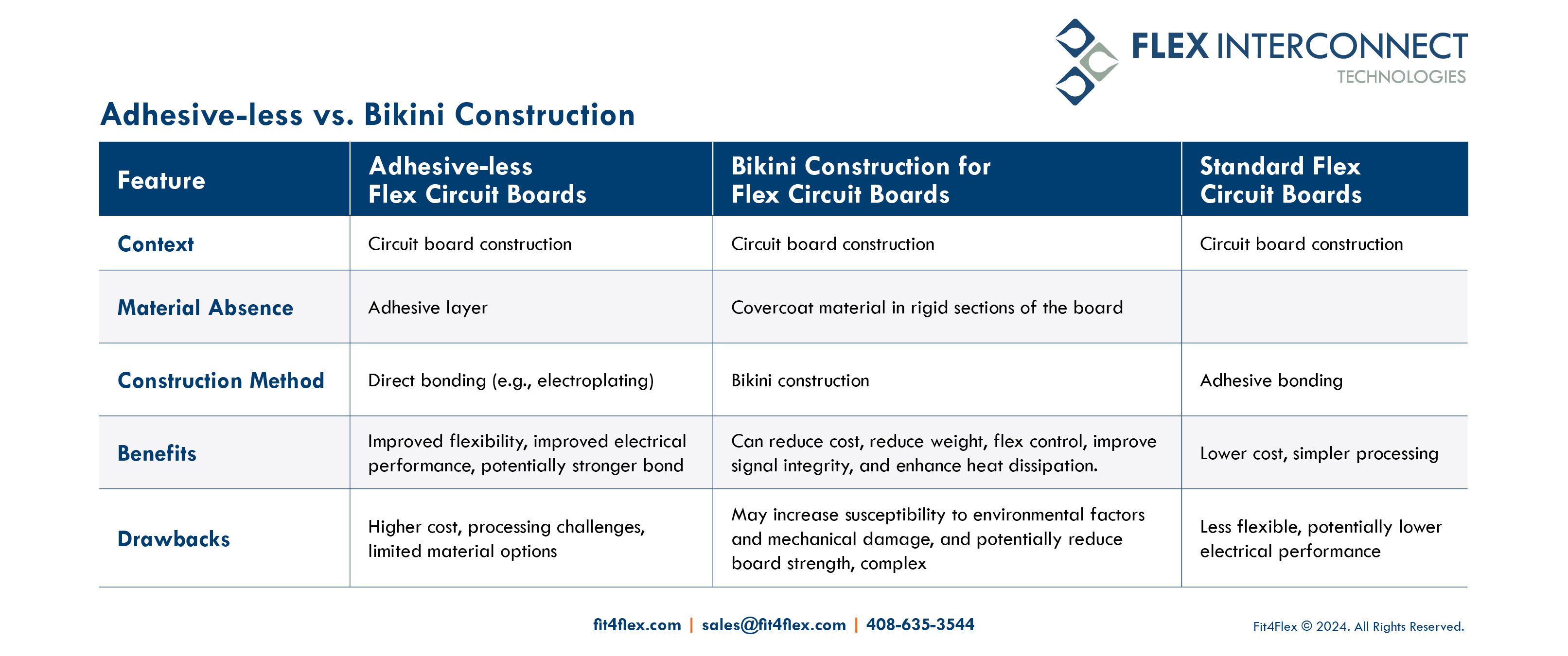Terms like “adhesive-less” and “bikini” are often used interchangeably. However, these terms carry distinct meanings, each contributing to unique aspects of the manufacturing process.
Adhesive-less
The term “adhesive-less” primarily refers to the material used for Flexible Metal Clad Laminate. This designation signifies the absence of adhesive in the laminate material, offering a unique approach to constructing circuits.
Why a manufacturer might consider Adhesive-less construction:
- Improved flexibility: The absence of adhesive allows for a thinner and more flexible laminate. This is crucial for applications where the circuit needs to bend or fold without causing cracks.
- Better electrical performance: Adhesive-free flexible metal-clad laminates can enhance high-frequency performance by eliminating electrical resistance and signal loss often associated with adhesives, for applications like RF circuits.
- Stronger bond: In some adhesive-less flexible metal-clad laminates, the metal layer is directly bonded to the base film through techniques like electroplating or sputtering. This can create a stronger bond compared to adhesive-based methods.
Considerations for Adhesive-less construction:
- Higher cost: Adhesive-less flexible metal-clad laminates often involve more complex manufacturing processes, leading to a higher cost compared to traditional adhesive-based methods.
- Processing challenges: Adhesive-less techniques can be more sensitive to surface preparation and process control. This can require more expertise and potentially lead to higher production scrap rates.
- Limited material options: Not all materials are compatible with adhesive-less bonding techniques. This can limit the design options for the engineer.
Bikini
Typically associated with the presence or absence of Covercoat material in the rigid sections of the board. When the Covercoat is removed or absent in these sections, the board is often referred to as having a “bikini” construction.
Why a manufacturer might choose a bikini construction:
- Lighter weight: Removing the covercoat in these areas reduces weight, which can be desirable for performance surfboards. A lighter board is generally considered more responsive and maneuverable.
- Flex control: The exposed foam core can allow for a bit more flex in the top and bottom sections. This can be beneficial for certain surfing styles that prefer a board with a bit more give for sharper turns or smoother paddling.
Considerations for bikini construction:
- Lower durability: The exposed foam is more susceptible to damage from dings and scratches compared to a board with a full covercoat. It can also be more prone to yellowing over time due to sun exposure.
- Water absorption: The exposed foam can absorb water, which can slightly increase the weight of the board over time and potentially affect its performance.
- Production complexity: Achieving a clean and polished finish with a bikini construction can be more labor-intensive compared to a full covercoat board.
Fusion of adhesive-less laminate with “bikini” construction
This combination yields a fascinating outcome: the absence of flexible adhesives, such as acrylic or epoxy, in the plated through holes (PTHs) within the rigid sections of the board. As a result, PTHs resemble those of rigid boards, with the added flexibility of polyimide layers in the flex sections. This combination offers a novel approach to circuit design, providing enhanced durability and flexibility without compromising performance.
In essence, the integration of adhesive-less laminate and “bikini” construction represents a shift in circuit manufacturing, offering a versatile solution for various applications. By understanding the nuances of these techniques, manufacturers can harness their potential to create cutting-edge circuits that meet the demands of modern technology.
Are you planning to utilize adhesive-less or “bikini” construction in your next project?


